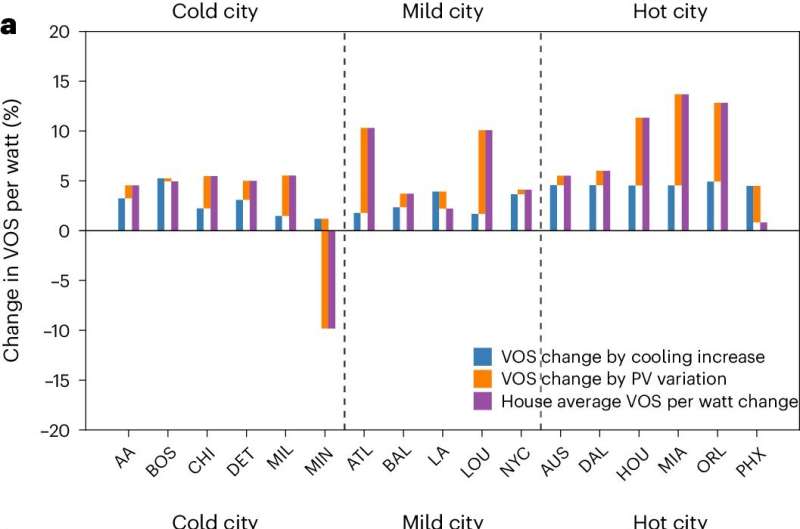
Climate change will increase the future value of residential rooftop solar panels across the United States by up to 19% by the end of the century, according to a new University of Michigan-led study.
The study defines the value of solar, or VOS, as household-level financial benefits from electricity bill savings plus revenues from selling excess electricity to the grid—minus the initial installation costs.
For many U.S. households, increased earnings from residential rooftop solar could total up to hundreds of dollars annually by the end of the century, say the authors of the study, which is scheduled for publication April 19 in the journal Nature Climate Change.
“Given the average 25-year lifespan of a rooftop solar installation, a system built today will nearly experience 2050 weather,” said study senior author Michael Craig, assistant professor of energy systems at the U-M School for Environment and Sustainability and of industrial and operations engineering at U-M’s College of Engineering.
“So, it’s important for households to think of future value when building solar. If households do so, our findings indicate they would see even greater value from solar, and might decide to build more.”
Public awareness of the increased future value of rooftop solar could spur greater adoption of the technology, which in turn could accelerate efforts to decarbonize the power-generation system in the United States and globally, the study shows.
The expected financial gains seen in the study were driven largely by increased demand for residential air-conditioning as the climate warms. The other key factor affecting the value of rooftop photovoltaic systems, the researchers say, is future solar-panel performance in response to climate change.
Craig and colleagues analyzed data from 2,000 households in 17 U.S. cities and estimated air-conditioning demand and solar-panel performance under future climates using a moderate climate-warming scenario called RCP-4.5.
The value of rooftop solar panels increased in nearly all the cities, in both warm and cold locations. Miami saw the largest increase in value, while only Minneapolis saw a decrease in the financial benefits of rooftop solar for households.
“This is the first study to quantify the value of rooftop solar under climate change, and we show that households across the U.S. will realize greater cost savings from rooftop solar under future weather than under historic weather,” said study lead author Mai Shi, a former U-M visiting doctoral student now at Tsinghua University in Beijing.
As home-cooling demands rise, a greater proportion of solar-generated electricity will be used to cool the home, rather than being sold to the electrical grid, benefiting owners of rooftop solar systems, according to the study.
That’s because—in many states—solar energy used to power a home reduces the homeowner’s electric bill by the full retail cost of electricity, while electricity that is sent to the grid is credited at a lower rate.
“Greater cooling demand means more solar power is consumed at the household rather than sent back to the grid,” Craig said. “And it’s generally more valuable for a rooftop photovoltaic owner to consume the power generated by their PV panel, rather than exporting it to the grid.”
Under the moderate RCP-4.5 climate scenario, demand for residential space cooling is expected to increase in all 17 cities studied. Cooling demand will increase by an average of 35% by mid-century and by an average of 64% by the end of the century, across all households in all of the cities, the researchers say.
The other key factor affecting the future value of residential rooftop photovoltaics is solar-panel performance in response to rising air temperatures and changes in cloud cover.
Solar panels work best in cool, sunny weather. As air temperature or cloud cover increase, the amount of electricity generated by a solar panel declines. The study found that future solar-panel performance will vary from place to place across the U.S., depending on weather conditions.
In cities such as Ann Arbor, Austin, Chicago, Dallas, Detroit, Houston, Louisville and Milwaukee, rising air temperatures will decrease solar panel efficiency, but reduced cloud cover will likely increase the amount of sunlight reaching panels, on average. The two factors “are opposing but roughly comparable,” meaning they cancel each other out, the researchers say.
But cities such as Baltimore, Boston, Los Angeles, Minneapolis, New York City and Phoenix are expected to be both warmer and cloudier in response to climate change, which will “significantly decrease” the electrical output of rooftop solar.
Even so, increased cooling demand in all 17 cities will likely outweigh changes in panel electrical output, resulting in financial gains for owners of rooftop solar in nearly every case, according to the study. Minneapolis, where limited future increases in cooling demand will combine with decreased electrical output from rooftop solar panels, is an exception.
While future financial gains from rooftop solar will be reaped mainly by households that can afford to install panels, various programs are in place to increase accessibility, so that more people share in the anticipated benefits, Craig says.
For example, there are programs that defray the costs of solar, opening it up to lower-income individuals. Governments can also install rooftop solar on public buildings, such as subsidized housing, to cover the capital costs while providing solar benefits to tenants. And community solar programs can benefit entire communities, including households that lack the means or ability to access rooftop solar themselves.
In addition to Craig and Shi, the other author of the paper is Xi Lu of Tsinghua University.
More information:
Climate change will impact the value and optimal adoption of residential rooftop solar. Nature Climate Change (2024). DOI: 10.1038/s41558-024-01978-4
Citation:
Climate change will increase value of residential rooftop solar panels across US, study finds (2024, April 19)
retrieved 24 June 2024
from https://techxplore.com/news/2024-04-climate-residential-rooftop-solar-panels.html
This document is subject to copyright. Apart from any fair dealing for the purpose of private study or research, no
part may be reproduced without the written permission. The content is provided for information purposes only.



